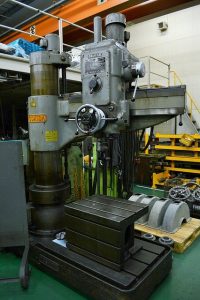
Manufacturing companies often use heavy-duty industrial machines to deform workpieces, one of which is a pneumatic press. Like other presses, it’s capable of performing a wide range of manufacturing processes. Pneumatic presses can cut, punch, bend, draw and form workpieces. If you’re unfamiliar with them, though, you might be wondering how pneumatic presses are used in manufacturing.
What Is a Pneumatic Press?
A pneumatic press is a type of forming press that uses a pneumatic system to manipulate a workpiece via the aforementioned manufacturing processes. They typically feature a rectangular frame. After placing the workpiece in the middle of the frame, the top of the pneumatic press drops down to manipulate it.
Pneumatic presses work by applying pressure to workpiece. When a workpiece is placed in the middle of a pneumatic press, it will be exposed to pressure. The top of the pneumatic press will push down onto the workpiece. Due to the pressure behind it, the pneumatic press will then manipulate the workpiece.
Benefits of using pneumatic presses in manufacturing include the following:
- Supports workpieces in a variety of materials
- Low energy usage
- Doesn’t produce heat
- Cost-effective for mass-production processes
- Produces minimal noise during operation
- Offers control over the workpiece’s size and dimensions
Pneumatic Press vs Hydraulic Press
Some forming presses use a hydraulics system to manipulate workpieces. Known as hydraulic presses, they are capable of performing many of the same manufacturing processes as their pneumatic counterparts. Hydraulic and pneumatic presses aren’t the same, however.
Hydraulic presses are powered by a pressurized liquid. They feature a piston that moves down into a liquid-filled storage tank. As the piston presses into the liquid-filled storage tank, it creates pressure on the top plate, thus pushing the top plate into the workpiece. The liquid can’t expand inside the sealed storage tank, so it creates pressure in response to the piston.
Pneumatic presses, on the other hand, are powered by pressurized gas or air. They feature a cylinder that’s filled with pressurized gas or air. Like hydraulic presses, pneumatic presses leverage compressive forces to manipulate workpieces. The difference is that hydraulic presses use pressurized liquid, whereas pneumatic presses use pressurized gas or air. When compared to hydraulic presses, pneumatic presses are faster and easier to maintain.
In Conclusion
A pneumatic press is a type of forming press that uses pressurized gas or gas to maniupulate workpieces. It can perform everything from bending and drawing to cutting, forming and more.
